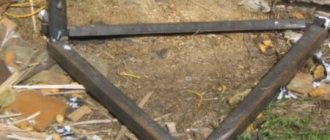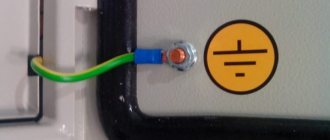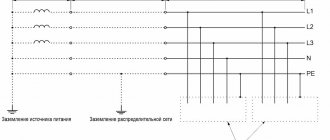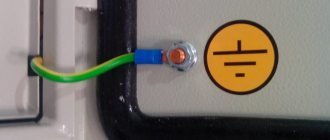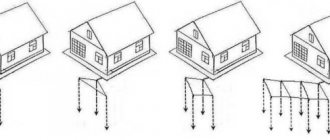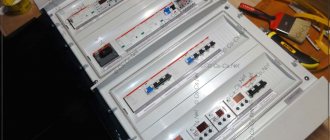The grounding wire is designed to protect a person from electric shock in emergency situations. For example, when the insulation breaks down, electrical contact occurs between the current-carrying elements and the device body. If a person touches such a device, electric current will flow through it to the ground, which can lead to electrical injury and even death. A current of 100 mA is considered dangerous for humans, which is why the probability of current flow must be minimized.
Rice. 1: Diagram of current flow during an electric shock
To eliminate the threat to human life, a grounding wire is installed in electrical installations. The ground wire provides an electrical connection between all conductive elements that are not normally at any operating potential with the ground loop. And if a potential arises on the case or other elements, the charge will flow through the grounding wire, and if there is protection, it will initiate its operation.
Despite the fact that the vast majority of grounding electrodes are installed for the purpose of human protection, there is also a category that is intended for performing work processes. Therefore, all grounding wires, in accordance with their purpose, can be divided into working and protective conductors. It should be noted that the danger of electric shock exists not only in the absence of a grounding conductor, but also in the event of its non-compliance with the requirements.
We scribbled down some comments.
There was a commission on the newly built panel, they wrote several comments, help us figure out whether they are all justified.
Maintain the distance between 0.4 kV cable lines laid in the basement in accordance with the requirements of Table No. 2.3.1 PUE. Table No. 2.3.1 shows the shortest distance for cable structures, but can the basement of a residential building be classified as such?
Connect waste collection chambers to the emergency lighting network based on the requirements of clause 4.8 “SP31-110-2003”. It seems like a correct requirement, the only reason why no one noticed this at the project stage, and as I understand the joint venture is of a recommendatory nature?
organizer wrote: Table No. 2.3.1 shows the shortest distance for cable structures, but can the basement of a residential building be classified as such?
complex issue. Most likely no.
A cable structure is a structure specifically designed to house cables.
organizer wrote: It seems like a correct requirement,
There are no ideal projects. I, as a designer, officially declare this to you.
organizer wrote: The joint venture, as I understand it, is advisory in nature?
why suddenly? The document is the most valid.
organizer wrote: Ie. Ground the panel door, is this necessary?
Well, of course! Is it difficult for you to make a door-body jumper from yellow-green PV-3 with bolts?
Alexiy wrote: why suddenly? The document is the most valid.
Somewhere I came across that the joint venture is not mandatory, although I may be mistaken.
Alexiy wrote: well, of course! Is it difficult for you to make a door-body jumper from yellow-green PV-3 with bolts?
There is not a door to the ASU, but the entrance door to the switchboard is meant.
organizer wrote: Somewhere I came across that the joint venture is not mandatory
It is the joint venture that is not mandatory, since it does not have legal force, but all the requirements, GOSTs and SNiPs collected there are very mandatory.
Alexiy wrote: The cabinet door/panel is cleverly connected with a jumper
Only if any electrical equipment is installed on the door.
the door is connected in any case and it doesn’t matter whether something is installed on it or not. Just like when you open a drawer, you still touch the door
amidant wrote: the door is connected in any case
And is there a standard regarding this?
avmal wrote: Only if any electrical equipment is installed on the door.
If the door to the electrical room is metal. A grounding strip is welded to the box. And from the strip to the door there is a PV3 wire with lugs. As well as ventilation holes and, accordingly, inscriptions and signs.
Bladiclab wrote: And from the strip to the door there is a PV3 wire with lugs.
I've never seen it. PUE clause 1.7.77 does not require this.
So in general, is there a standard that the entrance door to the panel room must be grounded? This is not the first time we are renting out a house, this is the first time we have had such a requirement. The inspector referred to clause 1.7.83 of the PUE, but it was about DSUP, but in fact they didn’t do any DSUP in the panel room, because there was nothing like that in the project. And the inspector didn’t write anything about the absence of DSUP in the control room.
organizer wrote: should the front door in the panel room be grounded?
I repeat for the 3rd time: read carefully the PUE clause 1.7.77
1.7.77. It is not necessary to intentionally connect to the source neutral in a TN system and to ground in IT and TT systems:
1) housings of electrical equipment and devices installed on metal bases: structures, switchgears, switchboards, cabinets, frames of machines, machines and mechanisms connected to the neutral of the power source or grounded, while ensuring reliable electrical contact of these housings with the bases;
2) structures listed in 1.7.76, while ensuring reliable electrical contact between these structures and the electrical equipment installed on them, connected to the protective conductor;
Here is the door to the 0.4 kV ShchSN room of the 500 kV switchgear building: outside view: inside view: as you can see, no flexible conductors.
Source
Color of conductors in the cable according to PUE 7, GOST R 50462 and GOST 31996
clause 1.1.29. For color and digital designation of individual insulated or non-insulated conductors, colors and numbers must be used in accordance with GOST R 50462 “Identification of conductors by colors or digital designations”.
Protective grounding conductors in all electrical installations, as well as neutral protective conductors in electrical installations with voltages up to 1 kV with a solidly grounded neutral, incl. tires must have the letter designation PE and a color designation with alternating longitudinal or transverse stripes and the same width (for tires from 15 to 100 mm) in yellow and green .
Zero working (neutral) conductors are designated by the letter N and the color blue . Combined neutral protective and neutral working conductors must have the letter designation PEN and color designation: blue along the entire length and yellow-green stripes at the ends
According to GOST R 50462
(GOST R 50462-2009 (IEC 60446:2007) Basic principles and safety principles for the human-machine interface, implementation and identification. Identification of conductors by means of colors and alphanumeric designations)
In accordance with Table A.1 of Appendix A. (read the original table)
AC electrical circuit
- Single-phase phase conductor - Brown
- Phase conductor 1 of three-phase circuit - Brown
- Phase conductor 2 three-phase circuit - Black
- Phase conductor 3 three-phase circuit - Gray
- Grounded phase conductor of a single-phase circuit - Blue
- Grounded phase conductors of a three-phase circuit - Blue
- Neutral conductor - Blue
DC electrical circuit
- Positive Terminal - Brown
- Negative Terminal - Gray
- Grounded Positive Pole Conductor - Blue
- Grounded negative pole conductor - Blue
- Middle conductor - Blue
Is it necessary to ground the doors of switchboards and cabinets?
Is it necessary to ground the doors of switchboards and cabinets? Where is this described in regulatory documents?
1.7.144. The connection of each open conductive part of the electrical installation to the neutral protective or protective grounding conductor must be made using a separate branch. The series connection of exposed conductive parts into the protective conductor is not permitted. The connection of conductive parts to the main potential equalization system must also be made using separate branches. The connection of conductive parts to an additional potential equalization system can be done using either separate branches or connection to one common permanent conductor.
Are there clamps for PE conductors on the switchboard doors? What is the protection class of the shield against electric shock?
GOST R 51778-2001 DISTRIBUTION BOARDS FOR INDUSTRIAL AND PUBLIC BUILDINGS 6.4.3 If electrical appliances are installed on the door of a class I panel, then the door should be additionally connected to the conductive housing with a flexible copper jumper.
GOST R 51732-2001 INPUT AND DISTRIBUTION DEVICES FOR RESIDENTIAL AND PUBLIC BUILDINGS 6.7.2 In ASUs of all types of class I, open conductive parts must have electrical connections among themselves and with the zero protective bus PE in accordance with 6.3.13 and meet the requirements of 6.7.5. In single- and multi-panel ASUs, these connections must withstand short-circuit currents in accordance with 6.8.2. If electrical devices are installed on the door of the ASU, then the door should be connected to the conductive frame or shell with a flexible copper jumper.
Source
Coloring phase
In cases where the electrical installation is installed using rigid metal busbars, the tires are painted with indelible paint in the following colors:
- yellow - phase A (L1);
- green - phase B (L2);
- red - phase C (L3);
- blue - zero bus;
- longitudinal or inclined stripes of yellow and green color - grounding bus.
The color of the phases must be maintained throughout the entire device, but not necessarily over the entire surface of the bus. It is allowed to mark the phase designation only at the connection points. On a painted surface, you can duplicate the color with the “ ZhZK ” symbols for paint of the corresponding colors.
If tires are not accessible for inspection or work when there is voltage on them, then they may not be painted.
The color of phase wires connected to rigid busbars may not coincide with them in color, since there is a difference in the accepted designation systems for flexible conductors and rigid stationary distribution busbars.
Comments
If necessary, then how correctly (only the door frame is enough, or is the door leaf also needed) and on the basis of what document?
User, August 29, 2013
Is it necessary to ground (for example, by connecting to the main potential equalization system) metal entrance doors to the entrances of residential buildings? The doors are equipped with intercom devices (intercom with an electromagnetic lock), powered by a voltage of 12-15 V through power supplies. Power supplies (PSUs), in turn, are located either in floor panels on the 1st floor or in metal boxes in the entrance vestibules. The housings of floor panels and metal boxes are naturally grounded: floor panels - by connecting to the PE conductor of the apartment power distribution line, metal boxes with power supplies - to the PE conductor of the 220 V network that powers the power supplies themselves.
If necessary, then how correctly (only the door frame is enough, or is the door leaf also needed) and on the basis of what document?
Sergey, here is the expert’s answer to your question.
Additional potential equalization provides for the connection of all metal building and industrial structures, which include doors and gates. If doors and/or gates are equipped with an electric drive or any electrical receivers (electrical devices) are installed on them, then they must be connected to a protective grounding system.
Source
Grounding system terms
Before moving on to considering the rules for installing grounding, it is necessary to define the terms used by specialists when carrying out this type of work.
- Firstly, what is a grounding device? This is a structure consisting of a grounding conductor and grounding conductors.
- Secondly, what is a ground electrode? This is a metal conductor that is directly connected to the ground.
- Third, what are grounding conductors? This is a system of metal conductors that connect the ground electrode to electrical equipment.
Please note that grounding an electrical installation artificially is called intentional. There is such a thing as the resistance of a grounding device. This is, in fact, the sum of the resistances of the grounding conductor and grounding conductors. If we talk about the resistance of the ground electrode itself, then this is the voltage relative to the ground to the current passing through the metal conductor.
Requirements for an electrical panel door
To fully commission the electrical panel, it is necessary to fully comply with the requirements set out in the profile standards. This also applies to doors that are installed here. Basic installation rules, as well as technical parameters, are set out in the “Rules for Electrical Installations”, as well as SN 31-110-2003. The latest standard deals with the rules for the design and installation of electrical installations for public and residential buildings.
List of basic requirements
Before installing electrical panel doors, we recommend reading the requirements below.
What kind of door can be installed in a transformer substation?
One of the requirements for arranging a substation specifies what technical doors should be installed in the room and what requirements they should meet.
Of course, doors for transformer rooms are selected only on the basis of existing rules, otherwise they may not be accepted by the relevant authorities carrying out control.
Requirements for technical doors for a substation
At the moment, the following requirements are accepted and actively used:
Fire doors to a transformer substation must comply with standard EI 60. It states that the door leaf must withstand direct contact with an open fire for 60 minutes.
Requirements for doors to the electrical room
The electrical control room, like any other technical room, has a number of requirements for arrangement, which relate to the distance of passages, ceiling heights, as well as entrance door blocks. Doors for electrical rooms must fully comply with the current SN 31-110-2003, and the developed rules for the design of electrical installations. Only compliance with such criteria gives the right to install a door into the room.
Doors to the electrical room requirements pue
Requirements for doors in the electrical room:
According to the basic requirement, the door must be all-metal, however, options for installing wooden panels trimmed with metal sheets are allowed. In this case, it is very important to comply with the fire safety level. That is, the door must withstand open fire for 0.75 hours.
Standard requirements for transformer substation gates
The manufacture of gates for transformer substations takes into account all established standards and regulatory documents. Only such compliance allows the facility to be put into operation. The following are considered standard parameters of finished structures:
GOST transformer substation gate
One of the main parameters that gates must meet is the fire resistance class. According to the current GOST, the minimum time for gate resistance to open fire is at least 35 minutes.
One of the main tasks performed by gates for transformer rooms is to reduce the likelihood of fire spreading. Gates with louvres and nipple openings must be fire resistant.
For this purpose, during the manufacturing process, it is recommended to use a frame structure covered with 2 mm steel sheets. The internal filling of the canvases is carried out with fiberglass material, which increases the level of safety of the structure.
Ensuring normal air exchange in the transformer room can be achieved by mounting ventilation grilles on the surface of the gate. The dimensions of such grilles are calculated based on the area of the room and the power of the installed equipment. Installation work on the installation of transformer gates can be carried out by companies or persons who have the appropriate permit.
Work technology
We select the location of the grounding conductors. Of course, not far from the house (facility), so that you do not have to lay a long conductor, which will have to be mechanically protected. It is advisable that the entire contour area be located on the territory that you control (you are the owner). So that one fine moment, your protective “ground” will not be dug up by a drunken excavator operator. So we won’t hammer in the pins behind the fence.
A vegetable garden (with the exception of a potato bed), a front garden, or a flower bed near the house will do. Cultivated areas are preferable and are regularly watered. And additional moisture in the ground will benefit grounding. If your soil has low resistivity, you can install grounding on the site, which will then be covered with asphalt or tiles. Under artificial turf, the ground does not dry out. And the risk of damaging the ground loop is minimal.
Of course, future plans must be taken into account. If a garage with an inspection hole appears in the place where the circuit is installed in a year, it is better to immediately choose a quieter place.
Depending on the shape of the site, we choose the order of arrangement of the electrodes: in a line or in a triangle.
Important! Regardless of the location, there must be at least three vertical grounding conductors.
If a triangle is selected, we mark out a site of the appropriate shape with sides of 2.5–3 meters. We dig a trench in the shape of an equilateral triangle to a depth of 70–100 cm, a width of 50–70 cm. We know that all ground electrodes are connected to each other. The conductor must be deepened to a distance of at least 50 cm, taking into account the minimum ground level (for example, digging a bed). If a coating is laid on top, its thickness is not taken into account. Only clean soil.
You can select all the soil, not just around the perimeter of the trench. The result will be a triangular pit 0.7–1.0 m deep. The finished circuit can be filled with soil with low resistivity. For example, ash or ashes. The salts will penetrate into the ground and will help reduce the overall resistance to current flow.
Criteria for choosing a door to the electrical room
The arrangement of the electrical panel is carried out on the basis of accepted standards and norms, for which clear regulations have been established by the relevant authorities. The choice of door to the room and its parameters are prescribed in documents such as SN 31-110-2003 and “Rules for the construction of electrical installations”.
Doors electrical panel requirements pue
In order to quickly put a technical room into operation, it is necessary to strictly adhere to the basic rules when designing it.
Basic requirements that doors in an electrical room must meet:
The specified list of compliance criteria is only a small part of the total list. It is important to pay attention to such points as the presence of a window and a ventilation system. In the case of spruce, these elements are missing, then you need to select doors with a ventilation grille or double-glazed windows.
Source
